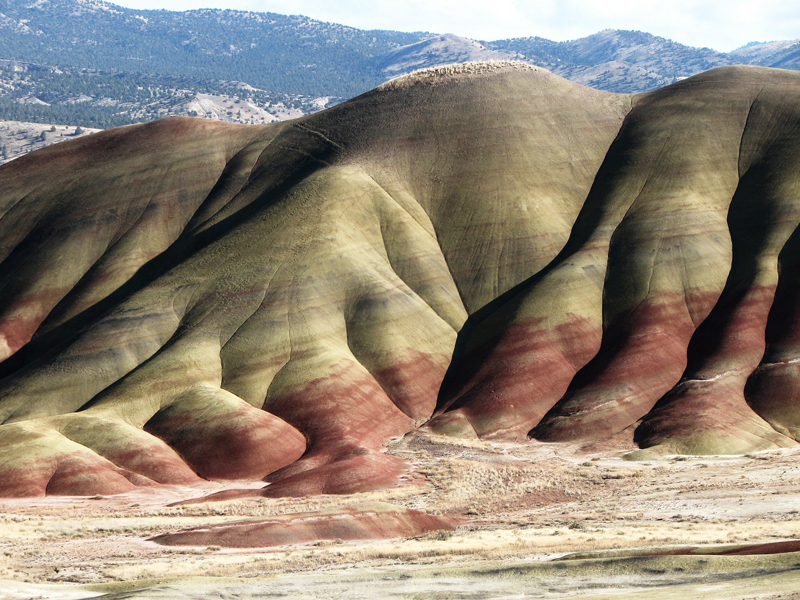The John Day Fossil Beds National Monument is a national monument-type sanctuary in the state of Oregon,In the United States.
The park is known for its well-preserved fossils of ancient plant and animal fossils that lived from 45 to 5 million years ago. The park territory consists of three distinct parts: Sheep Rock, Painted Hills and Clarno The park was founded on October 8, 1975.
On the territory of the park, there is an opportunity to get acquainted in the best possible way with the well-preserved fossil fossils of the flora and fauna of the planet.
John Day Fossil Beds Park in Oregon consists of three geographically separated areas: Sheep Rock is located between Dayville and Kimberly, Painted Hills is 15 kilometers northwest of Mitchell, Clarno is located on Highway 218, 36 kilometers west of Fossil.
The park’s office and visitor center is located in the Sheep Rock Unit, 196 kilometers northeast of Bend and 390 kilometers southeast of Portland.
The reserve got its name from the John Day River. The nature of these places is extremely picturesque, and the land is rich from a geological point of view and unique from a paleontological point of view, therefore the reserve has a special status – a national monument and is protected by the state.
In addition to being a scenic area, the area is one of the richest sites for fossils.Every summer, paleontologists work in the area to document and preserve fossils.
The old visitor center in the historic Cant Ranch near the Paleontology Center was subsequently rebuilt and, in addition to the management of the park, now houses an exhibition on the settlement and cultural history of the region. There are no accommodations, campsites, or restaurants in the park itself.
The new Thomas Condon Paleontology Center – Visitor information, a fossil exhibition and the park’s research center are housed under one roof. The conveyance of content is mainly done through educational trails and individual information boards.
Access : Coordinates: 44.555833, -119.645278 / Address 32651 Highway 19
Kimberly, OR 97848, USA / The John Day Fossil Beads National Monument is located in the state of Oregon, USA.
Highlights :
- The park contains only fossils of plants and animals, mainly from the Age of Mammals.The John Day Formation is divided into several geological subunits, the so-called members.
Kimberly-Member: The rocks of this stratigraphic unit are gray to slightly pink. They arose from clayey ash deposits. The most important fossil site is around 24 million years old.
Bridge Creek Member: This unit contains numerous animal and plant fossils at 33 mya. The plant fossils indicate that the region’s climate had become cooler and drier. For the first time, the seasons caused a change in living conditions.
Haystack Valley Member: A fossil deposit in the sand and ash deposits of the alluvial cone of a continental basin, which later hardened to sandstone with embedded tuffs, is around 20 million years old. - Rattlesnake formation : :The youngest rocks in the reserve are around 6–7 million years old. They are made of tuff and emerged from the ash flows from massive volcanic eruptions.
- Mascall formations : Tuff stone banks and sandstones alternate above the Picture Gorge basalt. They were deposited between 15 and 12 million years ago. The tufa banks were created from volcanic ash and the sand and silt stones are to be interpreted as floodplain sediments
- Clarno formation :The Clarno Formation contains the oldest rocks in the area, formed in the Eocene (Paleogene) about 54 million years ago. About 44 million years ago, a lahar, a mud flow from a volcanic eruption, buried a largely stable, subtropical forest for a long time. In the petrified sediments between the mud flows, over 175 different plant species of this forest have so far been found and documented
- Picture Gorge Basalt : the entire region of today’s protected area was covered by basaltic lavas: the Columbia plateau basalt. The thin but continuous flood basalt layer is free of fossils.
- Hikes , Several hike trails in the park /Opening hours : Daily from 10:00 to 17:00, excluding public holidays.
Go next : Kimberly , a small town in Eastern Oregon, the closest town to John Day Fossil Beds National Monument. / Mitchell, Oregon , only 12 miles from the Painted Hills national monument / Prineville west of the park.

